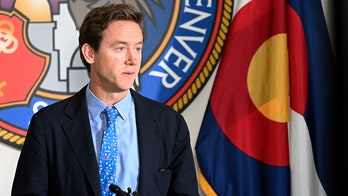Fox News Flash top headlines for February 12
Fox News Flash top headlines are here. Check out what's clicking on Foxnews.com.
The Centers for Disease Control and Prevention on Friday said the adverse effects on children conducting virtual learning outstrip the threat of transmitting the virus during in-school learning, but the agency is not demanding that schools reopen.
"Schools can be reopened safely prior to all teachers being vaccinated," said CDC Director Rochelle Walensky.
"There is more spread that is happening in the community when schools are not open than when schools are open," the CDC Director told reporters, adding that if schools are closed there are lots of other risks such as lack of education, food insecurity and milestones being missed.
The CDC issued new school reopening guidelines amid the coronavirus pandemic, reassuring schools that they are not demanding they reopen but are instead providing roadmaps on how to do so safely.
"I understand that this may be one of the hardest decisions you’ve had to make since the pandemic began," Walensky said Friday, outlining how to get kids back into classrooms nationwide. "I want to ensure you that our operational strategy is science-based."
The Department of Education has partnered with the CDC to release the first of several expected handbooks on how schools should implement mitigation strategies to help safely reopen in-person teaching -- including guidance on masks, cleanliness, ventilation, social distancing, weekly testing and the potential for pod-based learning when possible.
SAN FRANCISCO CITY ATTORNEY FILES FOR EMERGENCY COURT ORDER TO OPEN PUBLIC SCHOOLS
The Biden administration vowed to get the majority of schools reopened during his first 100 days in office, but several teachers unions across the nation have pushed back on re-entering the classroom.
Under the Trump administration, the CDC issued guidelines on school reopening, creating a five-tiered risk assessment. The CDC, in September, said that a school falling into a "medium," "higher" or "highest" risk category did not necessarily mean that the school shouldn’t reopen for in-person learning, only that the school should use "alternative learning models" like hybrid learning.
Last month, the federal agency said in a report that there is "little evidence that schools have contributed meaningfully to increased community transmission."
Biden has pledged to reopen most of the nation's K-8 schools within his first 100 days in office, a goal he says is possible if Congress approves his pandemic rescue plan and if states prioritize teachers in vaccine rollouts.
The Biden administration has said they want to see 50% percent of schools open at least one day per week. But according to Burbio’s school reopening tracker, the White House goal was reached months ago – about 64% of schools already offer some sort of in-person learning.
"The president wants schools to open safely and in accord with science, and we are going to listen to science and medical experts," White House Press Secretary Jen Psaki said this week, adding that Biden "will not rest" until every school is open five days a week.
Psaki detailed the specifics of that goal: a majority of schools, over 50%, would be open at least one day per week.
"Certainly, we are not planning to celebrate at 100 days if we reach that goal," Psaki said when pressed about it on Wednesday. "We certainly hope to build from that."
"That is not the ceiling, that is the bar we are trying to leap over," the press secretary added.
Asked if Biden thought schools that were already open were being unsafe, Psaki said: "One of the challenges we have is that the data is not great – as it relates to schools that are open or not open, how hybrid learning is impacting kids.
Psaki denied that a majority of schools are already reopened in some fashion. Burbio aggregates data from over 1,200 school districts throughout the country, including the 200 largest districts, in every state of the U.S. It measures traditional in-person, hybrid and virtual learning.
CLICK HERE TO GET THE FOX NEWS APP
The White House has pressed the need for more funding to reopen schools safely, in pushing for Biden's $1.9 trillion relief package to be passed by Congress.
The proposal includes $350 billion for state and local governments, to be divvied up among helping keep frontline workers employed and aid with vaccine distribution, COVID-19 testing, reopening of schools, and "maintaining other vital services."





